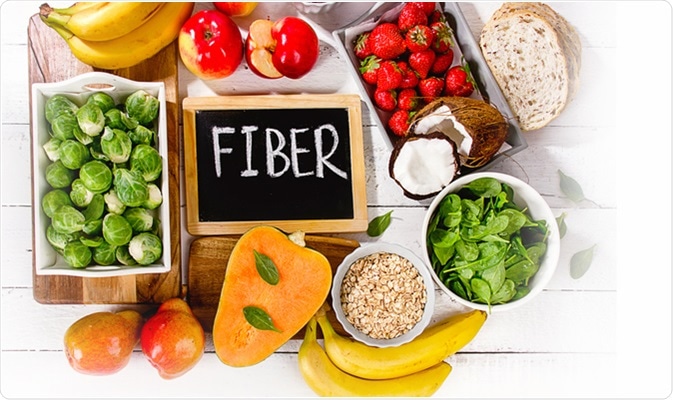The terminology ‘dietary fiber’ is believed to be first coined by Dr. E. Hipsley, who considered it an indigestible component of the plant cell. Since then, many have conferred different views on dietary fiber. Some view it as a functional substance with health benefits for the consumer and food industries, as well as being a powerful marketing point.

High Fiber Foods. Image Credit: bitt24 / Shutterstock
Chemists see it as a complex entity comprising several compounds. The currently accepted definition is “remnants of plant cells resistant to hydrolysis (digestion) by the alimentary enzymes of man.” It may be digested or form the substrate for fermentation by gut microbiota, either complete or partial. Human gut enzymes can break down only α-glucoside bonds, but fiber polysaccharides contain non-α linkages.
Dietary fiber includes cellulose and hemicellulose, lignin, oligosaccharides, gums, waxes, mucilages and pectins, all of which fall into two categories: soluble and insoluble.
Types of dietary fiber
Soluble fiber forms a gummy substance when added to water, and includes pectins, mucilages and gums. It can help to lower blood glucose levels and reduce fat absorption, as well as to lower the levels of cholesterol in the blood. Foods that provide adequate amounts of soluble fiber include oats, legumes (pulses or beans), raw unpeeled apples, blueberries and nuts.
Insoluble fiber remains intact when in contact with water. It is thus useful in increasing gut motility, moving food through the intestine and preventing the stasis of toxins in the gut lumen. It also traps water, thus increasing stool volume and helping to soften and regularize stool movement. Foods that are rich in insoluble fiber include whole grains, such as whole wheat, brown rice, carrots, tomatoes and cucumbers, as well as legumes. Whole grain bread is also part of this group. Insoluble fiber includes cellulose and hemicellulose with lignins.
While natural sources of dietary fiber include whole grains, legumes, nuts and seeds, as well as fruit and vegetables, today fiber supplementation ensures that many foods not traditionally considered fiber-rich have been made so by the addition of fiber.
What are the Physiological Mechanisms of Dietary Fiber?
Why should we eat fiber-rich foods?
Fiber helps to lower blood cholesterol levels. It thus lowers the risk of cardiovascular disease, obesity and type 2 diabetes. Dietary fiber also improves satiety, and thus reduces overall food intake, which helps to achieve a healthy body mass and to lose weight. The recommended daily intake of fiber is about 30g per day.
Sources of dietary fiber
Various plant foods contain differing amounts of fiber, and the percentage also varies with the maturity and plant part. For instance, the content of cellulose is high in the following:
- Root vegetables
- Leafy vegetables
- Legumes or pulses
- Certain fruits such as pears and apples
Lignin content is high in strawberries and peaches, while pectins are found in high quantities in citrus fruits. Cereals and grains are rich in both cellulose and hemicellulose.
Conclusion
The best sources of fiber are whole grain foods (7-12g/100g), fresh fruits and vegetables (peas and cowpeas approximately 5 g/100g, greens 3-4g/100g), and nuts (approximately 11g/100g).
It is recommended that whole fruits (1-10 g/100g) are eaten instead of fruit juice (0.1-0.5 g/100g), because, for instance, one medium apple gives about 4.4 g of fiber if eaten unpeeled, while in the form of applesauce it contains 2.8 g per cup, and in the form of juice, there is no fiber.
It is recommended to include brown rice and whole-grain foods instead of white rice and refined flour or flour products. It is important to know that foods labeled whole grain need not contain only whole grain but have partial replacement with fiber, carbohydrates and other nutrients in the same proportion as in whole grain. Breakfast cereals contain from 5-18 g/100 g of fiber. Legumes may be substituted for animal products several times a week.
Whole-grain foods should be chosen on the basis of a whole grain (WG) appearing first on the list of ingredients on the food label, such as oats, WG wheat, WG barley, WG rye, brown rice and popcorn. Minor cereals, such as quinoa, teff and millet may also be included in the diet on at least a sporadic basis to improve the fiber intake.
References
Further Reading
Last Updated: Mar 29, 2021